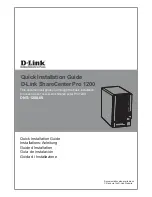
LSI Corporation
- 21 -
12Gb/s MegaRAID SAS Software User Guide
March 2014
Chapter 2: Introduction to RAID
Components and Features
2.1.6
Background Initialization
Background initialization is a check for media errors on the drives when you create a virtual drive. It is an automatic
operation that starts five minutes after you create the virtual drive. This check ensures that striped data segments are
the same on all of the drives in the drive group.
Background initialization is similar to a consistency check. The difference between the two is that a background
initialization is forced on new virtual drives and a consistency check is not.
New RAID 5 virtual drives and new RAID 6 virtual drives require a minimum number of drives for a background
initialization to start. If there are fewer drives, the background initialization does not start. The background
initialization needs to be started manually. The following number of drives are required:
New RAID 5 virtual drives must have at least five drives for background initialization to start.
New RAID 6 virtual drives must have at least seven drives for background initialization to start.
The default and recommended background initialization rate is 30 percent. Before you change the rebuild rate, you
must stop the background initialization or the rate change will not affect the background initialization rate. After you
stop background initialization and change the rebuild rate, the rate change takes effect when you restart background
initialization.
2.1.7
Patrol Read
Patrol read involves the review of your system for possible drive errors that could lead to drive failure and then action
to correct errors. The goal is to protect data integrity by detecting drive failure before the failure can damage data. The
corrective actions depend on the drive group configuration and the type of errors.
Patrol read starts only when the controller is idle for a defined period of time and no other background tasks are
active, though it can continue to run during heavy I/O processes.
You can use the MegaRAID Storage Manager software to select the patrol read options, which you can use to set
automatic or manual operation, or disable patrol read. See
2.1.8
Disk Striping
Disk striping allows you to write data across multiple drives instead of just one drive. Disk striping involves
partitioning each drive storage space into stripes that can vary in size from 8 KB to 1024 KB. These stripes are
interleaved in a repeated sequential manner. The combined storage space is composed of stripes from each drive. It is
recommended that you keep stripe sizes the same across RAID drive groups.
For example, in a four-disk system using only disk striping (used in RAID level 0), segment 1 is written to disk 1,
segment 2 is written to disk 2, and so on. Disk striping enhances performance because multiple drives are accessed
simultaneously, but disk striping does not provide data redundancy.
Figure 3 Example of Disk Striping (RAID 0)
Содержание ThinkServer RD650
Страница 1: ...ThinkServer 12 Gb s MegaRAID SAS Software User Guide ...
Страница 417: ......
Страница 418: ......
















































